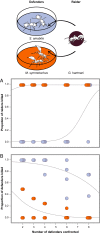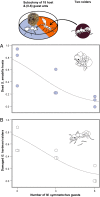Chemically armed mercenary ants protect fungus-farming societies
- PMID: 24019482
- PMCID: PMC3785773
- DOI: 10.1073/pnas.1311654110
Chemically armed mercenary ants protect fungus-farming societies
Abstract
The ants are extraordinary in having evolved many lineages that exploit closely related ant societies as social parasites, but social parasitism by distantly related ants is rare. Here we document the interaction dynamics among a Sericomyrmex fungus-growing ant host, a permanently associated parasitic guest ant of the genus Megalomyrmex, and a raiding agro-predator of the genus Gnamptogenys. We show experimentally that the guest ants protect their host colonies against agro-predator raids using alkaloid venom that is much more potent than the biting defenses of the host ants. Relatively few guest ants are sufficient to kill raiders that invariably exterminate host nests without a cohabiting guest ant colony. We also show that the odor of guest ants discourages raider scouts from recruiting nestmates to host colonies. Our results imply that Sericomyrmex fungus-growers obtain a net benefit from their costly guest ants behaving as a functional soldier caste to meet lethal threats from agro-predator raiders. The fundamentally different life histories of the agro-predators and guest ants appear to facilitate their coexistence in a negative frequency-dependent manner. Because a guest ant colony is committed for life to a single host colony, the guests would harm their own interests by not defending the host that they continue to exploit. This conditional mutualism is analogous to chronic sickle cell anemia enhancing the resistance to malaria and to episodes in human history when mercenary city defenders offered either net benefits or imposed net costs, depending on the level of threat from invading armies.
Keywords: Attini; Solenopsidini; evolutionary transition; symbiosis.
Conflict of interest statement
The authors declare no conflict of interest.
Figures




References
-
- Lenoir A, D’Ettorre P, Errard C, Hefetz A. Chemical ecology and social parasitism in ants. Annu Rev Entomol. 2001;46:573–599. - PubMed
-
- Akino T. Chemical strategies to deal with ants: A review of mimicry, camouflage, propaganda, and phytomimesis by ants (Hymenoptera: Formicidae) and other arthropods. Myrmecol News. 2008;11:173–181.
-
- Buschinger A. Evolution of social parasitism in ants. Trends Ecol Evol. 1986;1(6):155–160. - PubMed
-
- Buschinger A. Social parasitism among ants: A review (Hymenoptera: Formicidae) Myrmecol News. 2009;12:219–235.
Publication types
MeSH terms
Substances
LinkOut - more resources
Full Text Sources
Other Literature Sources
Medical

